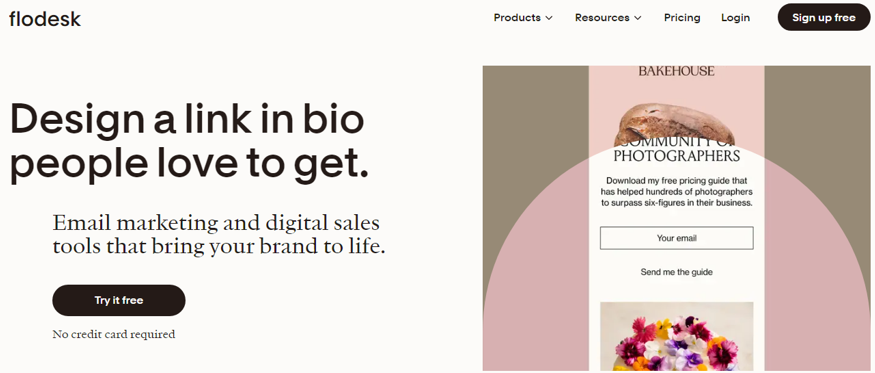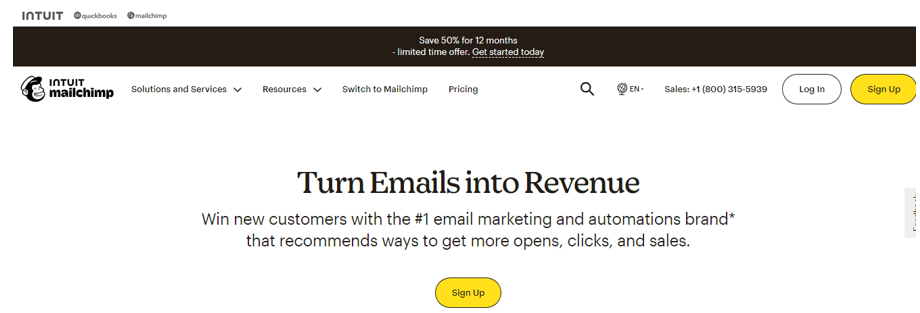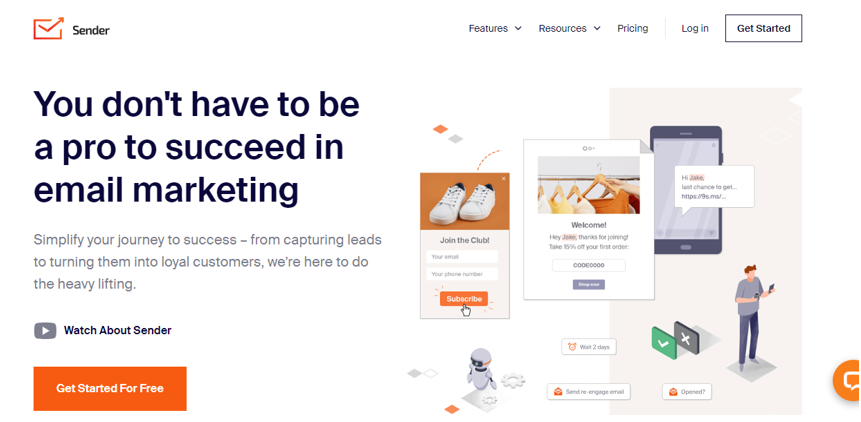When was the last time you checked your email?
Whether it was to catch up with friends, receive updates from your favorite brands, or stay informed about the latest deals, email remains an integral part of our daily lives.
But what if I told you that the power of email marketing extends far beyond the confines of your inbox?
For many businesses, email marketing is not just about sending messages but about crafting compelling campaigns that appeal to their audience and drive action.
However, with over 87% of marketers using email marketing, it can be a bit of a challenge standing out in the crowded inbox. To overcome this challenge, a synergy between email marketing and website development is needed.
In this article, we will explore:
- The significance of email marketing
- Top email design software
- Elements for effective website development
- The benefits of combining email marketing and website development
- And best practices for integration
Let’s get started.
What is Email Marketing?
Have you ever been so captivated by the content of an email that you were driven to click on an embedded link in the mail?
If yes, then that is email marketing.
It is a form of marketing that requires business owners to directly promote their products/services using email. If done correctly, it can help increase brand awareness, customer retention/loyalty, engagement and sales.
According to statistics, there are over 4.26 billion email users and a projected figure of $17.9 billion worldwide email marketing revenue by 2027. This goes to show that the market is increasingly progressive and there is no better time to join the moving train than right now.
Don’t know how to start?
There are various email template builders and email design software[1] you can use to design and automate your email marketing processes.
Let’s take a quick look at some of these..
Examples of email design software
An email design software is a tool that helps your business create attractive and engaging email campaigns.
Think of it as a digital workshop where you can easily design and customize the layout, graphics, and content of your emails.
Here are a few examples of some top email design software:
1. Flodesk

This is a software that helps take your brand to extraordinary new heights using exquisite imagery. With flodesk you can design emails, make beautiful sales pages, and grow with analytics.
The features included in this software are: email marketing, checkout, link in bios, analytics, email automations, and audience management.
2. Mailchimp

Mailchimp allows you to automate your emails, segment your potential leads, optimize your brand with analytical tools, and create a template with generative AI.
With Mailchimp, you can keep your customers ready to make a purchase using engaging content.
3. Sender

Sender simplifies your marketing efforts. They basically help with the heavy lifting when it comes to lead generation and customer retention.
The features on this platform include: email marketing, text marketing, email automation, text automation, integrations, and API.
Each of these tools are designed to simplify and streamline your email marketing processes.
Having explored the significance of email marketing and some of the top tools to use for it, let’s take a look at what website development really is.
What is Website Development?
In very simple terms, your web development is your digital storefront.
Just as a storefront functions to attract visual attention, your website serves as the front side of your business. It’s the first thing people see, and the development of this digital storefront determines whether they go in to engage with you and explore what you offer.
Website development involves creating, designing, and maintaining this digital space to ensure it’s welcoming, visually attractive, easy to navigate, and showcases your brand in the best possible way.
From the layout and design to the functionality and content, every aspect of your website development plays a crucial role in shaping the perception of your business to thousands of potential customers.
A well developed website should include certain key elements that guarantee its effectiveness.
Key elements for an effective website development
Below are 3 key elements that determines the efficiency of a website:
User experience (UX) design
This involves making websites easy and enjoyable for people to use. When someone visits your website, they are new to it, they do not know what to look for, or where to look.
The purpose of UX design is to help them navigate through the website as intuitively as possible. A good UX designer focuses on things like layout, navigation, and interactive elements to ensure that users can accomplish their tasks smoothly and without frustration.
Mobile responsiveness
When developing your website, keep in mind that not everyone has a laptop. Your website’s mobile responsiveness is the ability of your website to adapt and display properly on various devices, including smartphones and tablets.
A mobile-responsive website is one that adjusts its layout, content, and functionality based on the device’s screen size and orientation.
Search engine optimization (SEO)
It is generally believed that SEO comes after the development of the website, but in all honesty, it is way better to integrate SEO during the development phase.
You can do this by optimizing your website’s technical elements to ensure that search engines can crawl and index your pages effectively. Doing this includes optimizing your site structure, URL structure, internal linking, and fixing issues like broken links and duplicate content.
Also, a huge part of SEO involves conducting a website data privacy audit. Google tends to promote websites that clearly state data privacy measures and are compliant to privacy policies.
Now to the big question, how can you integrate email marketing and website development?
Keep reading to find out more.
How Can You Combine Email Marketing and Website Development?
Combining email marketing and website development can significantly redefine the success of your marketing campaigns.
Here are several best practices you can use to effectively combine these two marketing strategies.
Seamless Integration
Start by integrating several internal links to relevant pages on your website within your emails.
For instance, if you’re promoting a new product or service, you can include a call-to-action button that directly takes your customers or potential customers to a landing page on your website where they can learn more about the product and make a purchase.
When readers click the internal link, it drives traffic to your website, this encourages them to interact with your brand.
Personalized Content
The best way to resonate with your customers is to personalize your content, and this is so easy when you combine email marketing and web development.
How do you do this?
Start by collecting data from the website interactions and email engagement you get. Use this collected date to personalize your email marketing campaigns.
For example, if a customer visits a particular product page on your website but doesn’t make a purchase, you can send them a follow-up email with personalized product recommendations or exclusive offers related to their browsing history.
This creates a tailored experience that increases the likelihood of converting potential clients from leads to actual customers.
Consistent Branding
The branding and aesthetics on your website should align with the design and messaging of your email campaigns.
When branding and design aligns, it creates a cohesive and recognizable experience for your users regardless of the different channels they use in accessing your platform.
You can maintain consistency by using any of the email design software listed earlier in this article. Your ability to reinforce your brand identity helps you build trust with your audience.
Email Signup Forms
Pop-up forms and signup forms are some of the best ways to encourage visitors to subscribe to your email list.
For visibility, your email signup form should be prominently placed at the top of the homepage of your website, and subsequently on other landing pages. You can also offer incentives such as discounts or exclusive content to increase signups.
When potential customers subscribe, the next step is to nurture these leads through targeted email campaigns.
Track and Analyze Data
Analytical and tracking tools are designed to help you make informed data-driven decisions. Use them efficiently to track the effectiveness of your campaigns and identify areas for improvement.
Some analytical metrics to look out for include: open rates, click-through rates, and conversion rates.
Now that you know how to combine email marketing and web development to boost your marketing success, let’s wrap up this piece.
Conclusion
Congratulations, you made it this far!!!
Still thinking of whether or not to combine email marketing and website development?
Keep in mind that technology continues to evolve and consumer preferences shift rapidly. The best way to stay afloat, is to remain relevant in the digital space.
In an effort to do this and redefine your marketing success, utilizing the combination of email marketing and website development will offer you a powerful solution.
By seamlessly integrating email campaigns with website content and leveraging email design software to create visually appealing campaigns, you can engage your audience, drive traffic to your website, and ultimately, achieve your marketing goals.
I’m a DevOps/SRE/DevSecOps/Cloud Expert passionate about sharing knowledge and experiences. I am working at Cotocus. I blog tech insights at DevOps School, travel stories at Holiday Landmark, stock market tips at Stocks Mantra, health and fitness guidance at My Medic Plus, product reviews at I reviewed , and SEO strategies at Wizbrand.
Do you want to learn Quantum Computing?
Please find my social handles as below;
Rajesh Kumar Personal Website
Rajesh Kumar at YOUTUBE
Rajesh Kumar at INSTAGRAM
Rajesh Kumar at X
Rajesh Kumar at FACEBOOK
Rajesh Kumar at LINKEDIN
Rajesh Kumar at PINTEREST
Rajesh Kumar at QUORA
Rajesh Kumar at WIZBRAND

